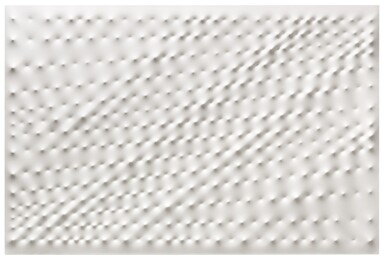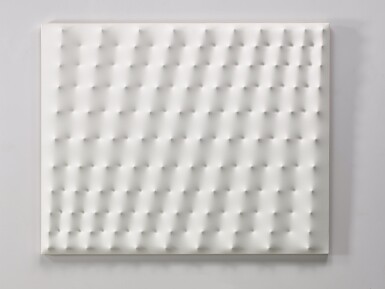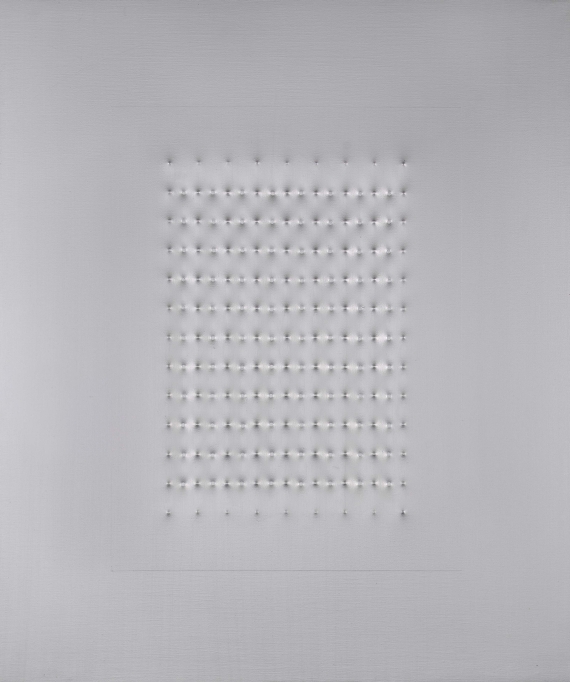Enrico Castellani Follow Superficie Gialla Tokyo no. 2 signed, titled and dated 'Enrico Castellani "Tokyo no. 2" 1967 "Superficie Gialla"' on the stretcher acrylic on shaped canvas 120 x 120 cm (47 1/4 x 47 1/4 in.) Executed in 1967, this work is accompanied by a certificate of authenticity from the Archivio Enrico Castellani and is registered under the archive number 67-061 and will be included in the forthcoming third volume of the Catalogue Raisonné being prepared by the Archivio Enrico Castellani
Provenance Galleria dell'Ariete, Milan Tokyo Gallery, Toyko Private Collection Exhibited Tokyo Gallery, Enrico Castellani Exhibition , 17 February - 9 March 1968 (illustrated on exhibition leaflet) Catalogue Essay Superficie Gialla Tokyo no. 2 , with its hypnotic surface of protrusions, exemplifies Enrico Castellani’s radical and prolific artistic practice. His iconic mastery of the inclinations of light and space, through the elegant manipulation of the two-dimensional canvas with rhythmic depressions and pointed projections, creates a captivating work that traverses the delicate balance between painting, sculpture and architecture. Included in the artist's exhibition at Tokyo Gallery in 1968, the present work has been in the same private collection ever since. Having originally experimented with the placement of hazelnuts underneath the canvas, Castellani pursued this idea and soon coined his characteristic, corrugated style of relief and indentation with the regular, orderly arrangement of nails beneath the taut canvas. A methodical and rigorous system that produced limitless variations and endless compositional possibilities, the nails were to become Castellani’s trademark practice, contributing to an extensive, even lifelong, artistic pursuit. Carefully distributed in complex, geometric formations, the work’s vitality is brought about not through painterly mark or gesture, but through the physical transformation of the medium of the canvas itself: ‘his work took on a metaphorical meaning – evoking a spasm that contracts and expands the surface – which became increasingly evident as he fine-tuned his grids. The initial patterns – relatively simple, regular lattices where light alternates with dark – became more and more complex, characterised by breath-taking perspectives that are still entirely understandable in geometric terms but are so strong as to cause vertigo’ (Angela Vettese, ‘Castellani, Master of Doubt’ in Enrico Castellani , exh. cat., Dominique Lévy, London and New York, 2016, p. 14). The year 1959 marked a dramatic change of direction in Castellani’s work, bringing about the beginning of the artist’s iconic Superifici (Surface) works, away from ‘painted paintings’ towards a more sculptural, architectural body of work. In a radical shift that saw the absolute rejection of the painterly subjectivity of the Surrealists or the Abstract Expressionists in favour of pure, monochrome canvases imbued solely with the tangible alternations of projections and indentations, Castellani became an essential figure in the pioneering art of the post-war Italian avant-garde. Along with his artistic contemporary and close friend Piero Manzoni the two established Azimut, a fleeting but nonetheless extremely significant exhibition space in Milan. With its accompanying publication Azimuth , the space showcased artists who, like the founders themselves, are now universally recognised as some of the greatest Italian artists of the twentieth century. Amongst these artists was Lucio Fontana whose revolutionary development of Spatialism had a profound impact on Castellani; as Castellani muses, ‘I admired him for going against the trends – for being an oppositional artist. Since we were young, this was very interesting to us’ (Enrico Castellani quoted in Hans Ulrich Obrist, ‘Breaking Away from Painting: An Interview with Enrico Castellani’, Enrico Castellani , exh. cat., Dominique Lévy, London and New York, 2016, p. 22). Azimut/h is rooted in a period of immense innovation and change that would go on to shape the future of contemporary art. Donald Judd went as far as to proclaim Castellani ‘the father of Minimalism’, as his work arguably contributed to the emergence of the American Minimalist movement in the 1970s, as well as facilitating the influential Zero movement in Europe. The artist’s Superifici also draw inherent parallels with the work of Yayoi Kusama whose Infinity Nets and installations mirror the artist’s concern with eter
Enrico Castellani Follow Superficie Gialla Tokyo no. 2 signed, titled and dated 'Enrico Castellani "Tokyo no. 2" 1967 "Superficie Gialla"' on the stretcher acrylic on shaped canvas 120 x 120 cm (47 1/4 x 47 1/4 in.) Executed in 1967, this work is accompanied by a certificate of authenticity from the Archivio Enrico Castellani and is registered under the archive number 67-061 and will be included in the forthcoming third volume of the Catalogue Raisonné being prepared by the Archivio Enrico Castellani
Provenance Galleria dell'Ariete, Milan Tokyo Gallery, Toyko Private Collection Exhibited Tokyo Gallery, Enrico Castellani Exhibition , 17 February - 9 March 1968 (illustrated on exhibition leaflet) Catalogue Essay Superficie Gialla Tokyo no. 2 , with its hypnotic surface of protrusions, exemplifies Enrico Castellani’s radical and prolific artistic practice. His iconic mastery of the inclinations of light and space, through the elegant manipulation of the two-dimensional canvas with rhythmic depressions and pointed projections, creates a captivating work that traverses the delicate balance between painting, sculpture and architecture. Included in the artist's exhibition at Tokyo Gallery in 1968, the present work has been in the same private collection ever since. Having originally experimented with the placement of hazelnuts underneath the canvas, Castellani pursued this idea and soon coined his characteristic, corrugated style of relief and indentation with the regular, orderly arrangement of nails beneath the taut canvas. A methodical and rigorous system that produced limitless variations and endless compositional possibilities, the nails were to become Castellani’s trademark practice, contributing to an extensive, even lifelong, artistic pursuit. Carefully distributed in complex, geometric formations, the work’s vitality is brought about not through painterly mark or gesture, but through the physical transformation of the medium of the canvas itself: ‘his work took on a metaphorical meaning – evoking a spasm that contracts and expands the surface – which became increasingly evident as he fine-tuned his grids. The initial patterns – relatively simple, regular lattices where light alternates with dark – became more and more complex, characterised by breath-taking perspectives that are still entirely understandable in geometric terms but are so strong as to cause vertigo’ (Angela Vettese, ‘Castellani, Master of Doubt’ in Enrico Castellani , exh. cat., Dominique Lévy, London and New York, 2016, p. 14). The year 1959 marked a dramatic change of direction in Castellani’s work, bringing about the beginning of the artist’s iconic Superifici (Surface) works, away from ‘painted paintings’ towards a more sculptural, architectural body of work. In a radical shift that saw the absolute rejection of the painterly subjectivity of the Surrealists or the Abstract Expressionists in favour of pure, monochrome canvases imbued solely with the tangible alternations of projections and indentations, Castellani became an essential figure in the pioneering art of the post-war Italian avant-garde. Along with his artistic contemporary and close friend Piero Manzoni the two established Azimut, a fleeting but nonetheless extremely significant exhibition space in Milan. With its accompanying publication Azimuth , the space showcased artists who, like the founders themselves, are now universally recognised as some of the greatest Italian artists of the twentieth century. Amongst these artists was Lucio Fontana whose revolutionary development of Spatialism had a profound impact on Castellani; as Castellani muses, ‘I admired him for going against the trends – for being an oppositional artist. Since we were young, this was very interesting to us’ (Enrico Castellani quoted in Hans Ulrich Obrist, ‘Breaking Away from Painting: An Interview with Enrico Castellani’, Enrico Castellani , exh. cat., Dominique Lévy, London and New York, 2016, p. 22). Azimut/h is rooted in a period of immense innovation and change that would go on to shape the future of contemporary art. Donald Judd went as far as to proclaim Castellani ‘the father of Minimalism’, as his work arguably contributed to the emergence of the American Minimalist movement in the 1970s, as well as facilitating the influential Zero movement in Europe. The artist’s Superifici also draw inherent parallels with the work of Yayoi Kusama whose Infinity Nets and installations mirror the artist’s concern with eter




.jpg)






.jpg)
.jpg)


Try LotSearch and its premium features for 7 days - without any costs!
Be notified automatically about new items in upcoming auctions.
Create an alert